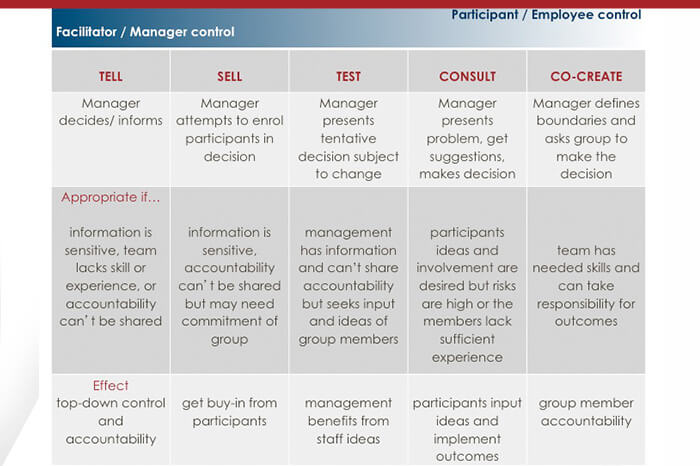As a leader or manager do you sometimes wonder when you should just tell your people of your decision, or should you involve them in the decision in some way? This is a common dilemma.
Bryan Smith seems to be the first one to use the framework above to clarify the issue in Senge at al, Fifth Discipline Fieldbook in 1994.
To help decide on the level of involvement of a manager or team in a decision the following factors need to be considered;
- The accountability for the outcome of the decision
- The sensitivity of the information
- The skill and experience of the team
- The effect you want
You TELL when the accountability can’t be shared, when the information is sensitive and the team lacks the experience or skill to make the decision. The effect of this is top-down control and accountability for the decision is held by the manager.
On the other hand a manager may still have the accountability for the decision, but it is important to have the team fully engaged in the issue and they need to implement the outcomes. In this case it is wiser to present the problem, get suggestions and ideas as to solutions, but in the end due to the level of risk, the experience of the team and where the accountability lies – the final decision needs to be made by the manager. This is in fact decision-making through CONSULTATION.
Indeed there is a range of levels of involvement or degrees of empowerment between managers and their people for making decisions. From TELL – SELL – TEST- CONSULT – CO-CREATE.
The diagram illustrates this spectrum and the factors that help you decide on the way a decision is made or communicated.
Equally common to this dilemma for managers is the muttering heard among staff – “they never consult us”. Often this is because the manager or decision-maker has not been clear as to why in the specific circumstances consultation is not the appropriate option.
Therefore managers and decision-makers need to be conscious of how they make decisions and who is involved and why, and more particularly communicate this clearly to the people involved.






